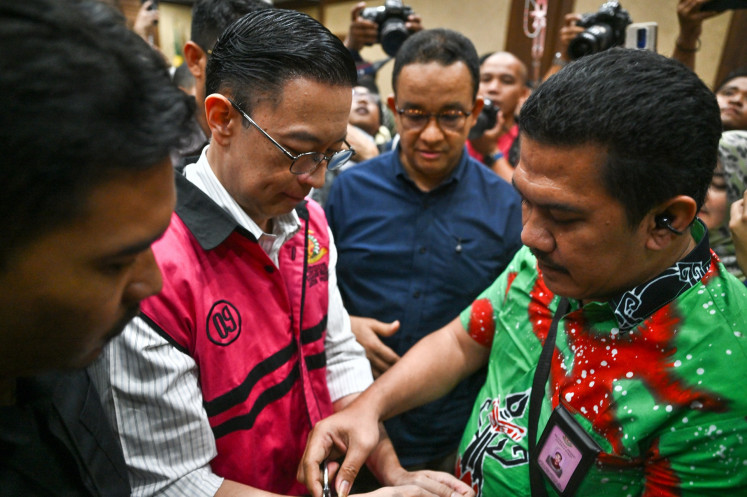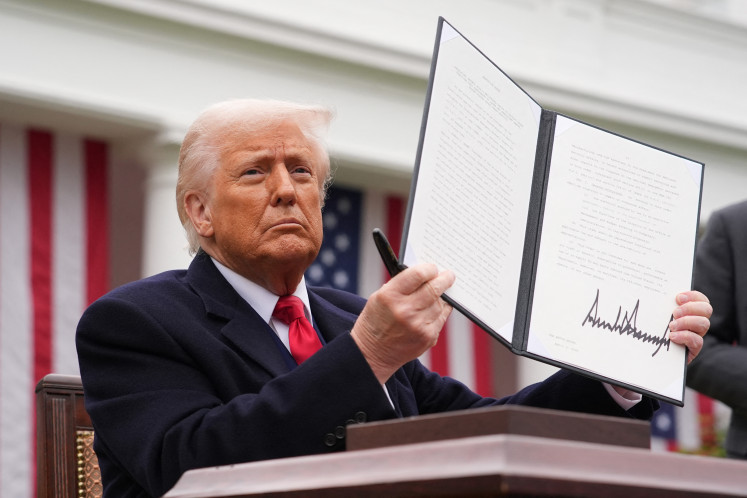Popular Reads
Top Results
Can't find what you're looking for?
View all search resultsPopular Reads
Top Results
Can't find what you're looking for?
View all search resultsIndonesia's climate plan signals a half-hearted promise
Mimicking the sky above most of Sumatra and Kalimantan after widespread forest fires in the past several weeks, Indonesiaâs post-2020 climate mitigation commitment â known as an Intended Nationally Determined Contribution (INDC) â remains hazy
Change text size
Gift Premium Articles
to Anyone
M
imicking the sky above most of Sumatra and Kalimantan after widespread forest fires in the past several weeks, Indonesia's post-2020 climate mitigation commitment ' known as an Intended Nationally Determined Contribution (INDC) ' remains hazy. Formally released last Thursday, Indonesia's INDC shows the country's intention to continue addressing climate change beyond 2020, albeit still lacking the robust information needed to safeguard effective implementation.
The pledge, submitted globally ahead of the Conference of Parties (COP) meeting in Paris in December, contains an unconditional target of 29 percent emissions reduction by 2030 compared to the business-as-usual scenario, or 41 percent provided international assistance. With this, Indonesia has cemented an extension to its voluntary 2020 mitigation goal, joining over 60 other countries that have announced their INDCs ' including the top two emitters, the US and China.
As the world's sixth-largest greenhouse gas emitter, Indonesia could significantly contribute to the global action of curbing warming to 2 degrees Celsius. Meeting this predefined limit ' based on a consensus by the international scientific community ' is extremely critical to avoid some of the most catastrophic consequences, such as rising sea levels, flooding and drought.
As an archipelagic state with thousands of low-lying islands and millions of people depending on agricultural activities, Indonesia is one of the most vulnerable countries to the adverse impacts of climate change.
While taking a big step forward by providing a quantified baseline for projected emissions in 2030 (2.9 GtCO2e), it is quite disheartening that the government removed several critical pieces of information from the previous draft circulated publicly, such as the estimated amount of funds required to accomplish Indonesia's conditional target (previously said to be at least US$ 6 billion), as well as a lack of sufficient detail on the modeling and assumptions used in the baseline.
Since the country promises to sizably increase mitigation ambition with support from the international community, releasing such information is key to building confidence and trust in the scale of its upcoming efforts.
However, Indonesia entailed sectoral targets to curb emissions, including landscape-based ecosystem restoration and 23 percent renewable energy mix in 2025 in its climate plan, among other actions. Given Indonesia's 2015 emissions profile, where land-based and energy-based activities make up 56 percent and 34 percent of total greenhouse gas emissions, respectively, it makes sense to focus on these top two sectors.
In the land-based sector, Indonesia aims to strengthen the protection and conservation of its remaining forests by reducing deforestation and forest degradation, restoring ecosystem functions and sustainable forest management.
Unfortunately, Indonesia's INDC did not provide a quantified target for these activities, nor did it elaborate on the country's plan to deal with its recurring forest and peatland fires, one of the country's greatest sources of emissions in recent years.
In the publicly accessed draft of INDC, Indonesia has actually proposed a social forestry target of 12.7 million hectares. It is quite disappointing to see that this target is absent from the final INDC submitted to the UN Framework Convention on Climate Change (UNFCCC), as such a target is consistent with the Forest Declaration endorsed by Indonesia during last year's UN Climate Summit. One of its action plans, the Bonn Challenge, is a global pledge to restore 150 million hectares of degraded land by 2050, where Indonesia could partake with 12 other countries committed to restoring around 60 million hectares of forest and landscape.
Having identified 29 million hectares of non-forested land under its forest estate legal zoning in recent statistics from the Environment and Forestry Ministry, Indonesia should not shy away from putting forward a bold restoration pledge. Such action could provide benefits such as considerably shrinking its land-based carbon emissions and improving people's livelihoods.
On top of this, Indonesia's moratorium policy that calls for no new licenses for primary forest or peatland conversion could be further reinforced by extending full protection to include secondary forests and existing concessions.
Moreover, Indonesia's renewable energy plan to quadruple the current renewable energy share of 6 percent within a decade would be a meaningful achievement.
Next to India's 40 percent and Brazil's 20 percent targets in 2030, Indonesia's pledge to move to renewables further galvanizes the global trend of phasing out fossil fuels.
With the country's abundance of renewable energy options ' ranging from geothermal (28,910 MW) and hydropower (75,000 MW) to ocean energy (49,000 MW) potentials ' Indonesia should be able to achieve this target.
A recent call for large investment in coal-fired power as part of the government's 35,000-MW electricity program, however, suggests that the renewable energy target will continue to compete with fossil-fuel based sources in the near term.
Remaining challenges, such as inadequate data infrastructure, legal framework and unidentified risks of investment, should be addressed as soon as possible, given the identified need of Rp 1.60 quadrillion (US$108 million) in investment to achieve this goal.
Indonesia's climate plan is promising but more assurances are needed to ensure the country will stay on course, especially given that the December conference will serve as a pivotal opportunity for Indonesia to secure support for a comprehensive national climate action plan beyond its 29 percent target following the ambitious scenario.
__________________________________
The authors, respectively, are country director and research analyst of World Resources Institute Indonesia, Jakarta










